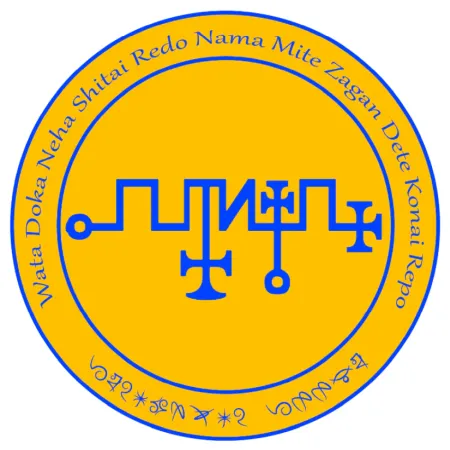Have you ever heard of the demon Zagan? Don’t feel bad if you haven’t. Many haven’t, but he’s one of the most powerful demons in Hell and a high-ranking lord in Hell’s hierarchy.
In fact, he’s some influential that his name appears alongside some of the most notorious demons like Baal, Asmodeus, and Belial in the most significant demonological texts, including the Ars Goetia, Pseudomonarchia Daemonum, and Dictionnaire Infernal.
So, who is Zagan, really? What are his mysterious origins, and what kind of terrifying powers does he possess? And why should anyone be afraid of him?
You’ll soon see why he’s such a formidable force in demon lore.
In this article:

The seal (sigil) of Zagan was first mentioned in The Lesser Key of Solomon. The grimoire contains detailed descriptions and sigils of 72 demons, including Zagan, each seal representing a unique mark used to summon and control the demon in ceremonial magic.
Who Is the Demon Zagan?
Zagan is one of the fallen angels featured in the “Ars Goetia,” the first section of “The Lesser Key of Solomon,” a cornerstone of demonology. He is identified as the 61st demon and carries the dual titles of “King” and “President.”
| Attribute | Description |
|---|---|
| Aliases | Zagam, Zagen |
| Titles | President and King of Hell |
| Race | Fallen Angel, Demon |
| Pantheon | Abrahamic, Goetic |
| Personifies | Transformation, Deception, Wealth |
| Appearance | Man with a bull’s head or griffin-like creature |
| Abilities | Transformation of metals (e.g., water to wine, metals to coins); adept in trickery and deception |
| Equipment | Alchemical symbols, tools of transformation |
| Associated Elements | Lead (symbolic of transformation), gold (associated with wealth) |
| Gem/Crystal | Pyrite, Amethyst |
| Associated Figures | Other alchemic or transformative demons in the Ars Goetia |
| Astrological Influence | Sometimes connected to Sagittarius (November 22–December 21) in some sources |
| Summoning Requirements | Seal of Zagan, often invoked in wealth or transformation rituals |
| Equivalents | Hermes (Greek god of commerce and transformation) |
| Affiliations | Hell, Ars Goetia, Alchemical Traditions |
| Alignment | Evil, often linked to trickery and greed |
| Historical Mentions | Ars Goetia, Dictionnaire Infernal, various alchemical texts |
Historical records tell us that Zagan commands 33 legions of demons. Some sources claim it’s 30. Either way, it’s a lot. So, he’s not just any random demon in Hell; he has real authority. And his powers go way beyond the usual—melding transformation and intellect in a way that really sets him apart.
Sources like the 1583 “Pseudomonarchia Daemonum” (“False Monarchy of Demons”) by Johann Weyer and the “Dictionnaire Infernal” (1863) by Jacques Auguste Simon Collin de Plancy describe Zagan’s powers, influence, and rank in the hierarchy of Hell.
For example, the “Pseudomonarchia Daemonum” tells us that:
“Zagam magnus Rex and Præses: ut taurus prodit cum alis ad modum gryphi: sed assumpta hominis forma, reddit hominem ingeniosum: transmutat cuncta metallorum genera in monetas illius ditionis, et aquam in vinum, et è diverso: sanguinem quoque in oleum, et contra: et stultum in sapientem. Præest triginta tribus legionibus.”
Which translates to English as:
“Zagan, a great King and President, appears as a bull with griffin’s wings. Once he takes on human form, he makes men clever. He transmutes all kinds of metals into coins of that dominion, turns water into wine, and vice versa: he also turns blood into oil, and conversely, and a fool into a wise man. He commands thirty-three legions.”
Why are these texts relevant? Because they are the most important sources that propose a detailed classification of demons. According to these sources, Zagan is a powerful demon who can help those who summon him with unimaginable fortunes and wisdom. But all comes with a price.

How Does the Demon Zagan Look Like?
Zagan’s appearance is distinct and loaded with symbolism. He first manifests as a bull with griffin wings—a mix that symbolizes the strength of a bull and the mythical wisdom of a griffin. This form represents his dominance and control over hidden knowledge.
Eventually, he transforms into a human form, appearing as a wise, thoughtful figure. Interestingly, this type of transformation is rare among demons. Only the most powerful demons can do that. And it’s a clear statement of their mastery over the physical world.
In some versions, Zagan is depicted as a bull-headed man with griffin wings. A strange mix of both human and mythological elements.
Zagan in Demonology and Occult Texts
The demon is mentioned in all the major demonology texts. For example, according to “Pseudomonarchia Daemonum,” Zagan is one of the 72 demons with significant influence in Hell.
SpookySight Note:
Weyer’s work laid the foundation for many later texts, including the “Ars Goetia” (a collection of grimoires compiled in the 17th century) and the “Dictionnaire Infernal” (which helped popularize demonology during the 19th century).
In the “Dictionnaire Infernal” (edition of 1863), Zagan is described as follows:
“Zagam, grand roi et président de l’enfer. Il a l’apparence d’un taureau aux ailes de griffon. Il change l’eau en vin, le sang en huile, l’insensé en homme sage, le plomb en argent et le cuivre en or. Trente légions lui obéissent.”
Which can be translated into English as:
“Zagam, a great king and president of Hell. He has the appearance of a bull with griffin’s wings. He changes water into wine, blood into oil, the fool into a wise man, lead into silver, and copper into gold. Thirty legions obey him.”
Zagan’s name also appears in several other grimoires, like “The Grand Grimoire” (which also links him to wealth and cunning transformation).
In later texts such as “The Book of Oberon” (a 16th-century magical manuscript), the demon is referenced for his material and intellectual transformative powers.
Abilities and Powers
Zagan is famous for his incredible transformative abilities. His powers go far beyond what most demons are capable of. Let’s break down some of his most notable abilities:
Liquid Transmutation
Zagan can transform liquids. For example, he can change water into wine, wine back into water, and even blood into oil or vice versa. Does that sound familiar?
This display of powers could be a mockery of what Jesus did at the wedding at Cana—as described in the Bible (John 2:1-11)—when he changed water into wine. It’s a common motif in demonological texts, where demonic powers often mirror or subvert religious miracles.

Metal Manipulation and Wealth
Zagan can manipulate metals and create wealth, turning base metals into coins. This directly links him to wealth and material gain, making him highly sought after by those wanting financial security.
But here’s the catch: the coins he creates are still made of the base material. So, while wealth can be gained, it’s not always in its purest form.
Let’s not forget that this is a high-ranking demon we are talking about. His power isn’t just about mortals getting rich. It’s all trickery and deception. Zagan is an unconventional means to success, often attracting those desperate for financial gain, even if it involves deception. After all, not everything that glitters is gold.
Wisdom and Intellectual Influence
Known as a “maker of wise men,” Zagan may have the power to sharpen the minds of those who seek his influence.
However, according to demonological texts, Zagan’s ability to grant wisdom is often described with a catch. After all, he is a demon, and nothing comes without a price.
The wisdom he grants could come at the cost of manipulation or deception, where the newfound “clarity” serves Zagan’s purposes as much as it benefits the summoner.
In this context, “maker of wise men” may refer to an intellectual boost that can temporarily empower the summoner. But this often comes with consequences.
Zagan’s wisdom is not pure. It could lead to overconfidence, misguided decisions, or even moral corruption. The trickery lies in the illusion of true understanding while being subtly led astray.







